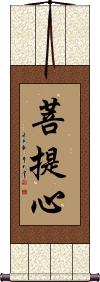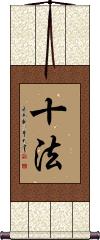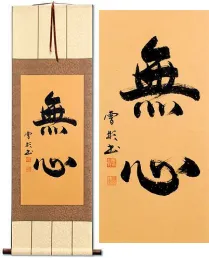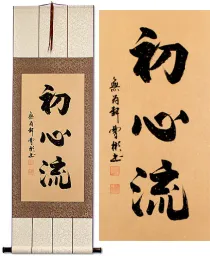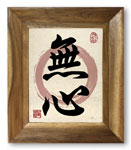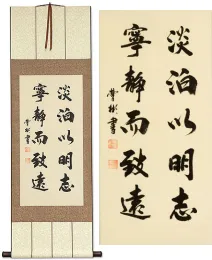Many custom options...
And formats...

The Bodhi Mind in Chinese / Japanese...
Buy a The Bodhi Mind calligraphy wall scroll here!
Personalize your custom “The Bodhi Mind” project by clicking the button next to your favorite “The Bodhi Mind” title below...
The Bodhi Mind
菩提心 means Bodhi-mind or Bodhi-heart.
This title represents the will to realize supreme enlightenment. The awakening of the Bodhi-mind is of utmost importance in Buddhist training.
Other definitions include the mind for or of bodhi, the awakened, enlightened mind, or having Buddha-nature.
7. Right Mindfulness / Right Memory / Perfect Mindfulness
Samyak Smriti / Samyak Smrti / Samma Sati
正念 is one of the Noble Eightfold Paths of Buddhism. Right Mindfulness, along with Right Effort and Right Concentration, constitute the path to Concentration or Perfect Thought.
Right Mindfulness is about remaining focused on one's body, feelings, mind, and mental qualities. It's also about being ardent, aware, and mindful, and supposes that you've already put aside worldly desire and aversion.
Monk Bhikkhu Bodhi described this as “The mind is deliberately kept at the level of bare attention, a detached observation of what is happening within us and around us in the present moment.” When practicing right mindfulness, the mind is trained to remain in the present, open, quiet, and alert, contemplating the present event.
Another definition: Ongoing mindfulness of body, feelings, thinking, and objects of thought.
This term is exclusively used by devout Buddhists. It is not a common term, and is remains an unknown concept to most Japanese and Chinese people.
See Also: Buddhism | Enlightenment | Noble Eightfold Path
Ten perfect Mahayana rules
十法 is the title of the ten perfect or perfecting Mahāyāna rules.
The order of rules is as follows:
1. right belief.
2. right conduct.
3. right spirit.
4. the joy of the bodhi mind.
5. joy in the dharma.
6. joy in meditation.
7. pursuing the correct dharma.
8. obedience to, or accordance with dharma.
9. departing from pride, desire, etc.
10. comprehending the inner teaching of Buddha and taking no pleasure in attaining such knowledge or noting the ignorance of others.
This title is only used in the context of Buddhism. Japanese and Chinese people who are not familiar with Buddhism will not recognize this title.
This in-stock artwork might be what you are looking for, and ships right away...
Gallery Price: $200.00
Your Price: $118.88
Gallery Price: $202.00
Your Price: $111.88
Gallery Price: $202.00
Your Price: $111.88
Gallery Price: $72.00
Your Price: $39.88
Gallery Price: $72.00
Your Price: $39.88
Gallery Price: $198.00
Your Price: $109.88
Gallery Price: $200.00
Your Price: $99.88
Gallery Price: $90.00
Your Price: $49.88
Not the results for The Bodhi Mind that you were looking for?
Below are some entries from our dictionary that may match your The Bodhi Mind search...
| Characters If shown, 2nd row is Simp. Chinese |
Pronunciation Romanization |
Simple Dictionary Definition |
十法 see styles |
shí fǎ shi2 fa3 shih fa jippō |
More info & calligraphy: Ten perfect Mahayana rules |
十問 十问 see styles |
shí wèn shi2 wen4 shih wen jūmon |
The ten questions to the Buddha, put into the mouth of Vajrapāṇi, which, with the answers given, form the basis of the 大日經. What is (or are) (1) the nature of the bodhi-mind? (2) its form or forms? (3) the mental stages requisite to attainment? (4) the difference between them? (5) the time required? (6) the character of the merits attained? (7) the activities or practices necessary? (8) the way of such practices? (9) the condition of the uncultivated and cultivated mind? (10) the difference between it and that of the follower of Yoga? |
四法 see styles |
sì fǎ si4 fa3 ssu fa shihō |
There are several groups of four dharma: (1) 教法 the teaching of the Buddha); 理法 its principles, or meaning; 行法 its practice; 果法 its fruits or rewards. (2) Another group relates to bodhisattvas, their never losing the bodhi-mind, or the wisdom attained, or perseverance in progress, or the monastic forest life (āraṇyaka). (3) Also 信解行證 faith, discernment, performance, and assurance. (4) The Pure-land 'True' sect of Japan has a division: 教法, i. e. the 大無量壽經; 行法 the practice of the seventeenth of Amitābha's vows; 信法 faith in the eighteenth; and 證法 proof of the eleventh. The most important work of Shinran, the founder of the sect, is these four, i. e. 教行信證. (5) A 'Lotus ' division of 四法 is the answer to a question of Puxian (Samantabhadra) how the Lotus is to be possessed after the Buddha's demise, i. e. by thought (or protection) of the Buddhas; the cultivation of virtue; entry into correct dhyāna; and having a mind to save all creatures. |
四重 see styles |
sì zhòng si4 zhong4 ssu chung shijuu / shiju しじゅう |
(noun - becomes adjective with の) fourfold (四重禁) The four grave prohibitions, or sins, 四重罪 pārājikas: killing, stealing, carnality, lying. Also four of the esoteric sect, i. e. discarding the truth, discarding the bodhi-mind, being mean or selfish in regard to the supreme law, injuring the living. |
有性 see styles |
yǒu xìng you3 xing4 yu hsing yuusei / yuse ゆうせい |
(noun - becomes adjective with の) sexual To have the nature, 'i. e. to be a Buddhist, have the bodhi-mind, in contrast with the 無性 absence of this mind, i. e. the闡提 icchanti, or unconverted. |
五相成身 see styles |
wǔ xiàng chéng shēn wu3 xiang4 cheng2 shen1 wu hsiang ch`eng shen wu hsiang cheng shen gosō jōshin |
(五相成身觀) A contemplation of the five stages in Vairocana Buddhahood— entry into the bodhi-mind; maintenance of it; attainment of the diamond mind; realization of the diamond embodiment; and perfect attainment of Buddhahood. It refers also to the 五智 of the Vairocana group; also 五轉成身 (or 五法成身) . |
心無所住 心无所住 see styles |
xīn wú suǒ zhù xin1 wu2 suo3 zhu4 hsin wu so chu shin mu shojū |
The mind without resting-place, i. e. detached from time and space, e. g. the past being past may be considered as a 'non-past' or non-existent, so with present and future, thus realizing their unreality. The result is detachment, or the liberated mind, which is the Buddha-mind, the bodhi-mind, 無生心 the mind free from ideas of creation and extinction, of beginning and end, recognizing that all forms and natures are of the Void, or Absolute. |
淨菩提心 净菩提心 see styles |
jìng pú tí xīn jing4 pu2 ti2 xin1 ching p`u t`i hsin ching pu ti hsin jō bodai shin |
Pure bhūtatathatā bodhi mind, or mind of pure enlightenment, the first stage of the practitioner in the esoteric sect. |
金剛寶藏 金刚宝藏 see styles |
jīn gāng bǎo zàng jin1 gang1 bao3 zang4 chin kang pao tsang kongō hōzō |
The 'Diamond' treasury i.e. nirvana and the pure bodhi-mind, as the source of the mind of all sentient beings, v. Nirvana Sutra. |
受菩提心戒義 受菩提心戒义 see styles |
shòu pú tí xīn jiè yí shou4 pu2 ti2 xin1 jie4 yi2 shou p`u t`i hsin chieh i shou pu ti hsin chieh i Ju bodaishin kaigi |
Taking the Precepts of Bodhi-Mind |
廣釋菩提心論 广释菩提心论 see styles |
guǎng shì pú tí xīn lùn guang3 shi4 pu2 ti2 xin1 lun4 kuang shih p`u t`i hsin lun kuang shih pu ti hsin lun kōshaku bodaishinron |
Extensive Explanation of the Treatise on Bodhi-mind. |
The following table may be helpful for those studying Chinese or Japanese...
| Title | Characters | Romaji (Romanized Japanese) | Various forms of Romanized Chinese | |
| The Bodhi Mind | 菩提心 | bo dai shin bodaishin | pú tí xīn pu2 ti2 xin1 pu ti xin putixin | p`u t`i hsin putihsin pu ti hsin |
| 7. Right Mindfulness Right Memory Perfect Mindfulness | 正念 | sei nen / seinen | zhèng niàn zheng4 nian4 zheng nian zhengnian | cheng nien chengnien |
| Ten perfect Mahayana rules | 十法 | jippou / jipo | shí fǎ / shi2 fa3 / shi fa / shifa | shih fa / shihfa |
Successful Chinese Character and Japanese Kanji calligraphy searches within the last few hours...
